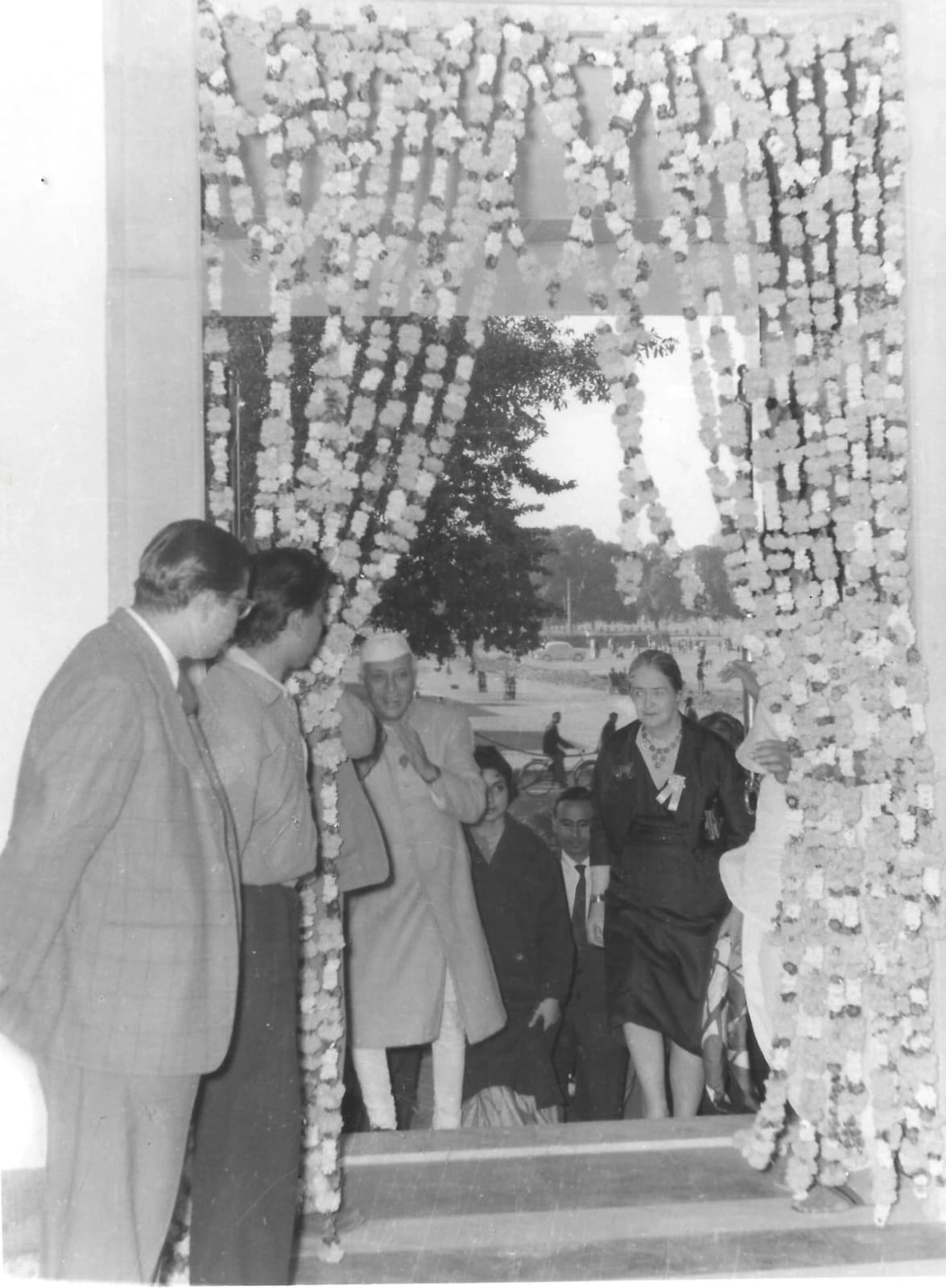
The National Museum stands as a cultural cornerstone, intricately weaving together the threads of a nation’s history, art, and heritage. It serves as a treasury of shared memories, housing artifacts, artworks, and exhibits that encapsulate the very essence of a people’s journey through time. Beyond its physical confines, the National Museum is a living narrative, a dynamic storyteller that mirrors the growth, accomplishments, and trials of a society. Situated in the heart of New Delhi, the National Museum of India stands as a venerable institution, embodying the rich cultural tapestry and profound historical legacy of the nation. Since its establishment in 1947, the museum has emerged as a custodian and curator of India’s diverse heritage, playing a pivotal role in preserving, interpreting, and presenting the multifaceted aspects of its past.
The museum’s sprawling premises house an extensive and varied collection that spans epochs, encompassing a remarkable array of artefacts, artworks, and antiquities. Each exhibit within the museum serves as a time capsule, inviting visitors to embark on a captivating journey through the annals of time.
As one navigates through the well-curated galleries, the National Museum unfolds a narrative that weaves together the artistic brilliance, cultural nuances, and historical milestones that have shaped the identity of India. From ancient civilizations to medieval dynasties, from artistic masterpieces to archaeological treasures, the exhibits on display showcase the depth and diversity of India’s heritage.
History of National Museum, New Delhi
The call for the creation of a National Museum of India dates back to July 26, 1837, when Sir James Princep, then Secretary of the Royal Asiatic Society of Bengal, formally proposed the idea in a memorandum to the East India Company. However, the realization of this vision took several decades, and it wasn’t until August 15, 1949, that the National Museum was officially established.
The blueprint for the establishment of the National Museum in Delhi was meticulously crafted by the Maurice Gwyer Committee in May 1946. The vision and efforts materialised when, on August 15, 1949, the National Museum, New Delhi, was inaugurated within the premises of Rashtrapati Bhawan. The inauguration ceremony was presided over by Shri R.C. Rajagopalachari, the Governor-General of India at the time.
The initial collection of the National Museum comprised around five hundred artefacts, originating from an exhibition of Indian arts and crafts that had previously travelled to Burlington House, London, during the winter of 1947-1948. These objects, which had been part of the London exhibition, found a temporary home in the state rooms of Rashtrapati Bhavan when the National Museum was first established. Established in 1947, the National Museum of India emerged as a symbol of the newly independent nation’s cultural aspirations. Its inception was rooted in an exhibition that journeyed to London in 1948 before finding a temporary home within the Rashtrapati Bhavan on Raisina Hill.
Constructed in the post-colonial era, the National Museum became a canvas for the unfolding narrative of modern identities and cultural practices in India. As noted by Tapati Guha Thakurta, a distinguished historian of art and art institutions, this cultural institution played a crucial role in challenging and reconfiguring these identities.
However, the evolution of the museum faced unexpected challenges, as highlighted by Saloni Mathur and Kavita Singh in their work, “No Touching, No Spitting, No Praying.” They underscored the resistance from India’s subaltern masses to conform to the prescribed cultural script of the museum visit. Instead, the masses transformed their visits into entertainment and a form of darshan, a spiritual dialogue between the numerous deities showcased and the devotee.
In India, museums are perceived by the “subaltern masses” as places of wonder and magic. Notable references include the Ajaib Ghar, immortalized in Rudyard Kipling’s “Kim,” and the immensely popular Jadu Ghar or Indian Museum. The latter attracts thousands en route to the pilgrimage at Ganga Sagar in the Sundarbans or during political rallies in Kolkata.

(The Newly Completed National Museum, 1960. Source – National Museum, New Delhi.)
The envisioned plan for the National Museum encompassed a three-part complex. The inaugural phase featured the main building, a significant milestone inaugurated by Jawaharlal Nehru. Subsequently, the second part materialized in 1989, contributing to the museum’s evolving structure. A crucial development occurred on December 18, 2017, marked by the laying of the foundation stone for the third and final segment, signaling a continued commitment to the museum’s expansion and enhancement.
(Grace Morley with then Prime Minister, Jawaharlal Nehru on the inauguration day, December 16, 1960 of National Museum. Source – National Museum, New Delhi.)
Grace Morley, the inaugural director of the National Museum, dedicated four years to the meticulous selection and arrangement of objects for display. Her expertise was sought by the government of Jawaharlal Nehru, and her previous role as the director of the San Francisco Museum of Art underscored her experience and proficiency in the field. Embracing the principles of cultural democracy, Morley played a pivotal role in shaping the display design of the National Museum.
In line with her vision, the museum’s presentation of sculptures adopted a format characterized by “secularisation and democratization.” The exhibition spaces were transformed into white cube environments, offering a neutral backdrop that allowed the artworks to speak for themselves. Noteworthy is the deliberate choice to provide minimal contextual information, allowing visitors to engage directly with the pieces and fostering a sense of democratic accessibility to the cultural treasures on display.

(The white cube aesthetic discouraged too much contextualisation and it was aimed that the artworks alone should speak. Source – Zikr – e – Dilli.)
The National Museum adopted a deliberate approach to showcasing its collection, and the reasoning behind this method was both profound and symbolic. Kavita Singh, in her work “The Idea of a National Museum,” articulated that the unique display strategy aimed to “celebrate the ancient culture of a young state.” This, she emphasized, was not merely an exhibition but “an act of great symbolic importance.”
Within this framework, the National Museum sought to accomplish a symbolic affirmation of the citizens’ rights by sharing the nation’s masterpieces. The curated display, particularly emphasizing the materiality of stone, notably in sculpture, transcended mere exhibitionism. Instead, it became a narrative tool for conveying a nationalist history. Through these carefully selected artifacts, the National Museum aimed to weave a cultural tapestry that connected contemporary citizens with the rich historical legacy of the nation.

(Model for the National Museum building, designed by Ganesh Bhikaji Deolalikar. Source – Zikr – e – Dilli.)
Demolition of National Museum in 2023
Three prominent cultural institutions, including the National Museum, the Indira Gandhi National Centre for the Arts, and the Annexe of the National Archives, are slated for demolition as part of the ambitious Central Vista project in Delhi. These designated museums, situated within the grandeur of Lutyens’ complex, are set to make way for the transformation of the North and South Blocks. Historically housing key ministries and the Prime Minister’s Office, these blocks are earmarked for the creation of museums that will narrate the stories of “The Making of India” and “India at 75.”
This redevelopment initiative is part of a broader vision to reshape Central Vista, a significant administrative and cultural district in the heart of the capital. While the project aims to provide a modern and efficient administrative hub, it has sparked controversy and debate due to the proposed demolition of culturally significant structures.
The National Museum, the Indira Gandhi National Centre for the Arts, and the Annexe of the National Archives, with their architectural splendour, have long been integral to the cultural fabric of Delhi. As they face the prospect of being replaced, concerns have been raised about the preservation of historical and cultural heritage. The envisioned transformation of the North and South Blocks into museums further adds a layer of complexity, emphasising the need for a delicate balance between modernization and the conservation of India’s rich cultural legacy.
The thematic focus of the proposed museums, “The Making of India” and “India at 75,” suggests an intention to showcase the nation’s historical journey and celebrate its achievements. However, the execution of this vision is entangled with questions of heritage preservation, public sentiment, and the potential loss of architectural gems that have stood witness to decades of history.
As the Central Vista project unfolds, it becomes a symbol not only of urban development but also of the intricate interplay between progress and the preservation of cultural identity. The fate of these cultural institutions and the transformation of the iconic North and South Blocks into museums are emblematic of the ongoing dialogue surrounding the vision for India’s future and the conscious navigation of its historical roots.
The stirring proposal to demolish the revered National Museum in New Delhi has ignited impassioned discussions and fervent debates. This landmark institution, a custodian of the nation’s cultural narrative, now grapples with the looming threat of demolition, sparking reflections on its historical significance and the potential consequences for India’s cultural tapestry. The contemplated demolition is accompanied by a set of justifications presented by proponents of the plan. Whether rooted in urban development ambitions, modernization imperatives, or structural concerns, deciphering the reasoning behind this bold decision is pivotal for a nuanced understanding of the situation. The announcement has triggered widespread public resistance, drawing objections from cultural enthusiasts, historians, and conservation advocates. This section delves into the varied perspectives and arguments put forth by those staunchly opposing the demolition, underscoring the intrinsic cultural and historical value embedded within the National Museum’s walls. Delving into the annals of the National Museum’s history, this segment accentuates its pivotal role in safeguarding and showcasing India’s diverse cultural heritage. The potential loss of this institution prompts reflections on the preservation of the nation’s identity and the profound importance of sustaining tangible links to bygone eras.
The discourse surrounding the demolition of cultural institutions, including the esteemed National Museum, encapsulates a complex interplay between progress, modernization imperatives, and the preservation of India’s rich cultural heritage. The National Museum, born out of a vision dating back to 1837 and officially established on August 15, 1949, stands as a custodian of the nation’s historical narrative and cultural treasures. Its journey reflects a commitment to celebrating the ancient culture of a young state and symbolically affirming citizens’ rights through the display of masterpieces.
However, the prospect of demolishing the National Museum, along with other cultural institutions, as part of the ambitious Central Vista project, has become a focal point of passionate discussions. While proponents argue for the necessity of urban development and the creation of thematic museums to narrate India’s story, opposition arises from those who emphasize the intrinsic value of preserving architectural gems and tangible links to the nation’s past.
The National Museum’s potential demise raises questions about the delicate balance required between progress and heritage conservation. The museum’s proposed replacement by thematic museums within the transformed North and South Blocks underscores the ongoing challenge of navigating the dual goals of modernization and the preservation of cultural identity.
As India grapples with the implications of these decisions, the fate of the National Museum becomes symbolic of broader debates on the nation’s vision for the future. The passionate objections from cultural enthusiasts, historians, and conservation advocates highlight the profound importance of acknowledging and safeguarding the tangible and intangible aspects of India’s diverse cultural heritage. The National Museum, with its storied history, stands as a testament to the nation’s commitment to preserving its past, even as it faces the uncertain prospect of transformation in the name of progress.
References
“With the Demolition of the National Museum, India Stands to Lose a Piece of its History.” 2023. The Wire. https://thewire.in/culture/with-the-demolition-of-the-national-museum-india-stands-to-lose-a-piece-of-its-history.
Singh, Kavita, and DH Sykes. 2021. “Moving the National Museum: Why the opacity about relocation plans should worry us all.” Scroll.in. https://scroll.in/article/995140/moving-the-national-museum-why-the-opacity-about-the-relocation-plans-should-worry-us-all.
“Bidding Adieu to the National Museum.” 2021. Zikr-e-Dilli. https://zikredilli.com/f/bidding-adieu-to-the-national-museum.“The Demolition of the National Museum Will Extinguish the Identity of an India That was Born in 1947.” 2023. The Wire. https://thewire.in/culture/the-demolition-of-the-national-museum-will-extinguish-the-identity-of-an-india-that-was-born-in-1947.
- May 15, 2024
- 6 Min Read






















